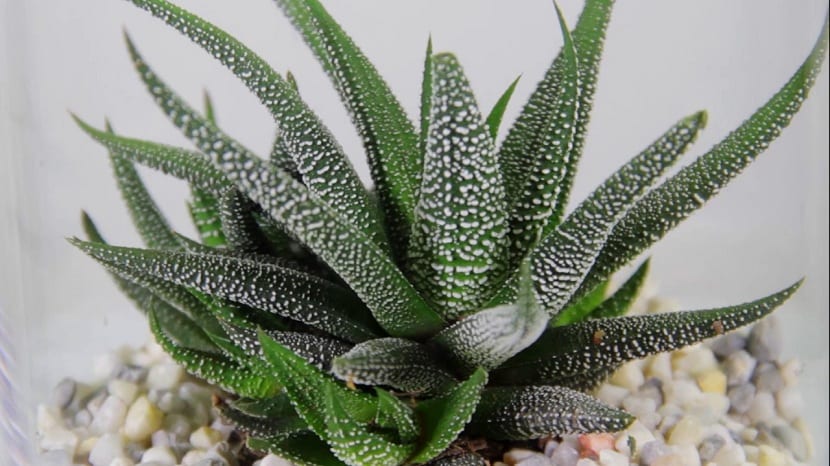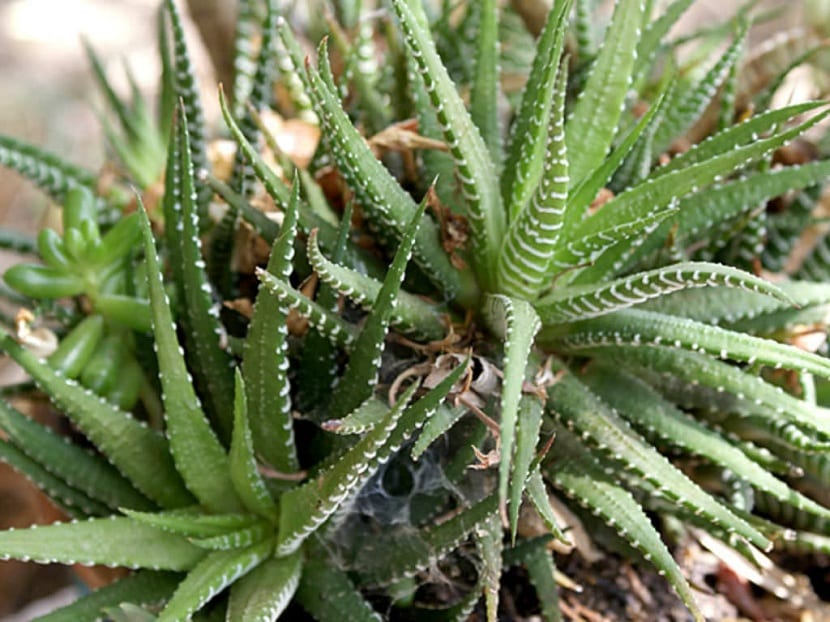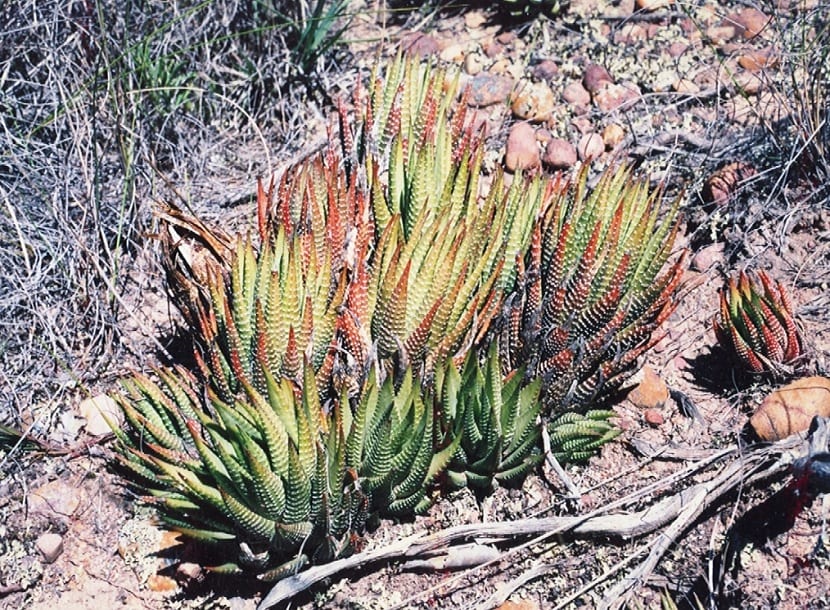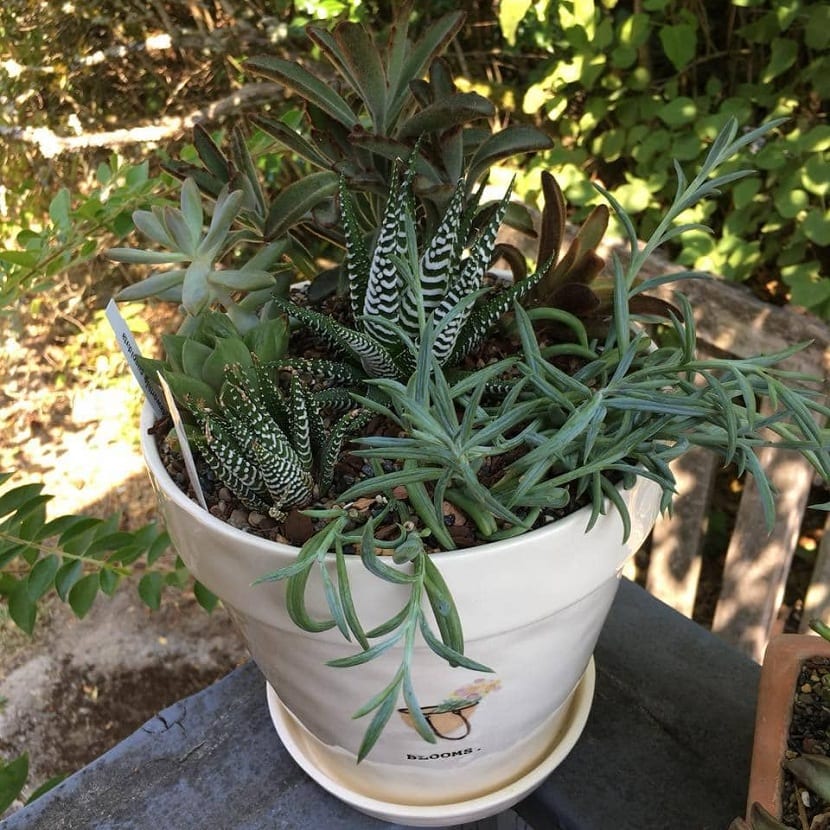
We are talking about a succulent whose common name is a zebra plant. It is quite known in this world of succulents since it is widely used and characteristic. Its scientific name is haworthia fasciata. Among other common names by which it is known we find zebra cactus or Haworthia zebra. It is not an entirely accurate name, since the plant is a succulent and not a cactus. It belongs to the Xanthorroeaceae family and comes from South Africa.
Here we are going to tell you all the characteristics of the haworthia fasciata and the main care you need.
Key features

It is a plant that has horizontal stripes that remind us of zebra stripes. This is why its common name is zebra plant. Being a succulent type plant, has some properties similar to those of Aloe since they are related to the same subfamily.
It is a perennial plant with a fairly small size. If you take good care of it and the conditions are good, it will probably not exceed 10 cm in height. Its leaves are triangular in shape with a green color and narrow stripes. It has white flowers that usually come out during the months of October and November. When it reaches maturity, we can find numerous rosettes grouped close together and of small size where there are also many leaves.
Being a succulent plant, it has a great capacity to retain water and withstand long periods of drought. They are plants that need many hours of direct sunlight and can withstand long periods without any drop of rain. Their resistance to drought comes from their ability to store enough water in their leaves. Also for this it is one of the reasons why it is often confused and called a zebra cactus.
The most widespread general use is that of its cultivation in gardens. However, there is also great demand for haworthia fasciata for growing in greenhouses and in pots for window decoration. It is a very suitable plant to grow in gardens with rockery.
Haworthia fasciata care
Although it is a plant whose cultivation and maintenance is very easy, it is convenient to review some aspects so as not to be disappointed when we have it cultivated.
Flowering and lighting

We are going to start by describing what its flowering is like and the lighting it needs as the main conditioning factor in its growth stage. As usual, It is a plant that needs a smaller pot so that the roots are more compact. Its flowers are white and tubular in shape, although we also find it pink. They can measure up to 10 cm in length. It has some narrow bands along the flower that can be green or reddish brown. They grow from an inflorescence.
Some long rods that are 30 to 40 inches in length also grow, but they can barely stand upright on their own. You need a tutor to be able to hold them well.
Regarding lighting, we have mentioned that it is a plant that needs to receive a large amount of direct sunlight. Therefore, if we are going to have it at home, we will have to find a location where it can receive the sun's rays. Depending on the orientation of our home, we can place it in a window where the morning sun gives it, which is the most favored for the plant. Ideally, it should receive at least 7-8 hours of sun a day. The areas of the house facing south-southeast are the most appropriate.
If we place it to the east or west of the house, it will be able to give more hours of direct sunlight during the day and it is more suitable. Too much sun at the warmest time of year can cause them to take on a reddish color and grow more slowly. In addition, the tips of the leaves can be dried. This indicator is the one that will indicate to us that we are passing with the sun.
Temperature and irrigation

This plant has a period of rest that exerts it during the winter. The optimum temperature so that this rest is not interrupted should be around 10 degrees. It can withstand some frost as long as the soil is dry and not filled with moisture. The worst time of year for haworthia fasciata it is winter. And it is that the lower temperatures are mixed with the humidity of rainy days, fresh air and cold currents that can make the plant sick or even kill it.
Therefore, if we have it indoors, the ideal is to place them on the window only when it is sunny. While, it is better to keep them indoors safe from cold and excessive humidity. The leaves are a great store of natural water that they have and, therefore, in winter it is hardly necessary to water it. It is necessary that the upper part of the earth can be dry in winter so that it does not have problems with excessive cold and humidity.
If the plant is young, it is better not to keep it in direct sunlight for a long time as it can damage it. Its leaves can get burned. Even as an adult, it is not recommended to keep them too long in direct sun during the hottest months. The optimal temperature range is between 18 and 26 degrees, never below 10 degrees.
The time in which it grows is from April to September. At this time it should be watered completely and not done again until the soil is dry to the touch. It should not be completely dry. In spring, water moderately and in summer also, but the rest of the year, it is almost never necessary to water. With the humidity of the environment it will be more than enough.
The time when you need fertilizer is between April and Septemberand. You can incorporate the fertilizer in liquid form with the spring and summer watering. With one subscriber per month is enough. In winter it does not need fertilizer.
I hope these tips help you take good care of Haworthia fasciata and you can have it decorating interiors or gardens.
What should it be planted with?
With earth or with stones?
Thank you
Hi Gael.
When it comes to succulents, I recommend using volcanic sand (pomx, akadama, or similar). But Haworthia live well with soil as long as it is mixed with perlite or another similar substrate.
Regards!
Hello Gael I bought a Haworthia to give my daughter Your advice on care was very useful because I did not know anything about this plant THANK YOU !! A hug
Good morning.
Thanks for the information.
A greeting.
We are glad that it has been useful to you, Javier 🙂
Hello, I have a small plate of these but when I plant it, its roots dry up, I put them in water and its roots grew. But I put it back on the ground and the roots dry out again. What advice can you give me? Thanks
Hi Yohana.
My advice is to plant it in a pot with mineral substrates (pumice, for example, or if you can't get peat mixed with very small pieces of clay). Don't put a plate under it.
Put it in semi-shade or shade, and water when you see that the substrate is dry (once a week or so).
Greetings.
Hello, a query about 1 year ago I returned to an old house that I have in Cusco; When I arrived I realized that in my garden I had several of those little plants but they were green. For following bad advice, he watered it all day; and suddenly the little plants changed to a brown color, besides that their leaves, instead of being an upright shape, are curved towards the center! I need help please!
Hi Jean.
They are on the ground? So my advice is not to water them until a long season has passed, and the soil has dried.
If they are in pots, take them out and remove the soil. Then, put new ones on them, and don't water for a few days.
Regards!
A little girl was born to my succu from the flower, what should I do? I can't find information anywhere
Hello Pau.
You can wait for it to grow a bit and then cut it down to plant in an individual pot if you want.
If you have doubts, tell us.
Greetings.
Good Morning! About a year ago I bought the hawortia fasciata, but in these last three days, I do not know what happens, that I find it every morning lying down and with the roots out, as if it did not want to be there.
I have it in a pot with universal substrate and with pearl fertilizer. Being summer, I keep it indoors so it doesn't burn and I water it occasionally with a diffuser so that it just picks up some moisture, as if it were the dew at night.
What can be caused this? Is there something I am doing wrong? We don't have animals at home and no one takes care of her except for me, so I don't understand why she "freaks out" every night. Thanks!
Hello Sergio.
If the pot is small, it may fall in the wind.
That is to say, the plant does not leave itself, and less from one day to the next. What does happen sometimes, with the passage of time, is that a plant has run out of space in the pot to grow in width, and it begins to do so vertically.
So my advice is to plant it in a slightly larger pot. You can even put small decorative stones on the surface of the substrate.
Greetings.